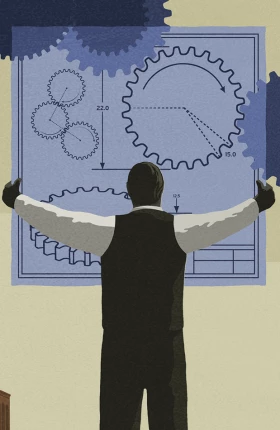Many companies have exhausted the traditional sources of cost savings in their purchased materials and services. They’ve designed products with an eye toward low-cost production, aggregated purchases and exercised their buying power with suppliers, adopted sophisticated tender and negotiation tools, and optimized logistics to further enhance savings.
What’s left when cost savings from these critical levers aren’t enough? Some companies are turning to their suppliers and service providers for new ideas, setting up hands-on workshops to dig deep into ways to further improve products, processes, purchasing performance, and logistics with the goal of reducing costs, shortening lead times, improving service, and enhancing quality. A fresh set of eyes with an outside perspective can be a catalyst for new ideas. That’s why we call these sessions catalyst workshops.
Too often, companies turn their interactions with suppliers and service providers into adversarial power plays, always pushing for lower prices. But price cuts rarely confer a sustainable market advantage. Instead, by working closely with these potentially valuable partners to rethink costs along the combined value chain, companies can change their underlying cost structure for a long-term competitive edge and access their suppliers’ best ideas. Unlike the traditional supplier relationship, this approach is collaborative rather than combative, win-win rather than win-lose. It focuses on total costs, not just price, and looks at end-to-end processes and the value chain as a whole instead of as separate pieces. Because the analysis is so far-reaching, suppliers and service providers, too, can find new ways to drive out costs from their operations, so all parties benefit. At the same time, relationships between companies and their key suppliers are strengthened.
The new ideas that catalyst workshops generate can lead to cost savings throughout the value chain—major, sustainable cost savings that might never have been considered otherwise. A typical session can deliver hundreds of cost-saving ideas, half of which can typically be implemented. In our experience, cost savings range from 2 to 8 percent per year per session for product-related workshops and up to 20 percent for service process improvements, although savings of up to 50 percent are possible. Repeating a session usually leads to further savings.
Making It Work
To succeed, a catalyst workshop must be carefully planned and orchestrated, using a well-defined and documented process. Most sessions set one or more specific objectives up front, such as reducing costs across the value chain, developing a leading cost position in an industry, or reducing the total costs of a service by a target amount. Cross-functional savings targets can be very useful—especially between purchasing and engineering, since design decisions can affect purchasing costs. The sessions can also focus on improving quality, service levels, or products.
It’s also helpful to set ground rules that encourage an open exchange of ideas and a focus on how ideas can be implemented—instead of on why they won’t work. Senior managers from your company and from the supplier should kick off the session to signal its importance. The following five measures are critical.
Set up mutually beneficial incentives. The critical question, What’s in it for me? must be addressed before the workshop so that suppliers are motivated to actively participate—and to trust in a positive outcome. Incentives may include a larger volume of business, longer-term contracts, or gain-sharing arrangements in which suppliers share any cost savings or increased profits that result from the workshop. Other potential benefits for suppliers are better information for planning and the ability to leverage new ideas with other customers or product groups. The key is to ensure that suppliers are motivated by clearly communicating the benefits up front.
Invite the right participants. A successful catalyst session depends on insights and ideas contributed by suppliers or service providers. Choose your candidates carefully, because not everyone will be well suited to this type of exercise. Look for long-term suppliers—those that have at least five or six years of experience with your company, know your industry, and understand the life cycle of your products or your pattern of demand for their services. Suppliers with a wide range of customers are especially helpful because they’ll have a good basis for evaluating how your products and processes compare with those of your competitors. Finally, look for valuable suppliers—those that provide critical inputs or services, a high volume of inputs, or innovation and design capabilities. At best, your business is as critical to the supplier as the supplier is to you, so you both have a stake in strengthening the relationship and finding ways to cut costs throughout the value chain. A supplier’s active participation—and the fresh insights and knowledge that an outsider can deliver—is pivotal to the success of a catalyst session.
To break down the silos that can impede breakthrough thinking, an effective session also requires the active participation of different functions within your company. When suppliers of product inputs are involved, participants will typically include specialists from marketing and sales, R&D, engineering, procurement, manufacturing, and logistics. When providers of services such as research, IT, legal, financial, contract manufacturing, or logistics are attending, include specialists from all the functions in your company that are touched by the services provided. Such cross-functional participation encourages everyone to focus on end-to-end processes and on solutions that may make no sense from a functional standpoint but can reduce costs overall. Finally, have a neutral party facilitate the session to keep it on track and ensure that the tough questions get asked—and answered.
Develop a fact base in advance. The supplier is usually expected to bring a number of cost-saving ideas to the session. Beforehand, all supplier participants should gather specific facts about direct and indirect costs, the supply chain, and your company and its competitors. Be sure to tailor the data request template to the supplier’s industry and situation. An important part of the fact base is a supplier survey that provides such information as how your company’s requirements compare with those of other buyers and how practices or processes vary. Typically, a supplier of product inputs will provide details of the value chain and offer benchmarks comparing your company with your competitors in areas such as process efficiency, product complexity, and product quality. Participants from your company should provide information on factors such as SKUs, pricing, product specs, and customer value delivery.
For service providers, the fact base is a baseline of total costs. Trust and data transparency are essential. Before the catalyst meeting, it is important to estimate all the cost drivers of the service from the bottom up. If possible, first analyze what it would cost to provide the service in-house instead of outsourcing it. Then work with the service provider to calculate its total costs.
As shown in the exhibit on the following page, the supplier’s cost structure should include all direct and indirect costs, selling costs, and a reasonable profit margin. For outsourced services, be sure to include any additional costs that your company has to take on, such as management oversight and any related activities that must be retained in-house. These total costs of ownership become the starting point for catalyst discussions on how to reduce costs and improve efficiency throughout the service provision process.
Create an idea matrix with specific improvement levers. The goal of a catalyst workshop is to create a matrix of cost-saving ideas prioritized according to their likely financial impact and ease of implementation. Give all participants time to share their ideas, and encourage everyone to think about how their ideas could be implemented. When the workshop involves a supplier of product inputs, many companies find it helpful to have actual products or components on hand—including those of competitors—or detailed photographs. These hands-on aids can help get the creative juices flowing. It can also help to brainstorm opportunities in major categories, such as products, processes, and purchasing.
Most product costs are driven by the complexity that arises from nonstandard customer requirements, proliferating SKUs, deviation from industry norms, unnecessary features or functions, and poorly designed products or processes. The right questions can get at these hidden cost drivers and trigger valuable ideas. For instance, an equipment manufacturer asked if any of its specific requirements added needless complexity—and costs—to the supplier’s production process. This question revealed that the OEM was the supplier’s only customer that submitted orders every ten days. Other buyers ordered weekly, so their orders could be fed into the ERP system. Because the OEM was off-cycle, its orders always had to be handled on an exception basis. By changing to weekly ordering, the company was able to cut costs by 2 percent. Another company learned that its nonstandard boxes were harder to load, stack, handle, and empty—and added to the supplier’s transportation costs. By switching to standard boxes, it was able to save 1.5 percent per year.
Other questions to ask might include the following:
Could we reduce warranty costs by increasing product reliability?
Could we standardize product requirements?
Could we substitute less costly materials or more standard components?
Where are the critical bottlenecks in the manufacturing process?
Could we bundle transport volume or increase the number of units per pallet?
Is there any way to simplify our storage requirements?
Questions such as these can generate ideas for reducing product costs and simplifying the processes related to manufacturing, logistics, packaging, and storing. To evaluate and prioritize these ideas, companies should consider factors such as the difficulty of implementation, the time and level of investment required, the potential effect on quality, and the relevance to customers.
For service providers, excess costs typically stem from handoffs, bottlenecks, nonvalue-adding steps, duplication of effort, poor communication, and other process inefficiencies. A detailed process-mapping exercise can reveal these costly problems and suggest levers for improvement. For instance, a pharmaceutical company that worked with an external provider of clinical-trial services wanted to cut outsourcing costs through closer collaboration. A detailed analysis of the supplier’s direct and indirect costs and the end-to-end process revealed a number of practices on the part of both supplier and pharma company that resulted in inefficiencies—and higher costs. These included unnecessary change orders and delays, excess oversight and duplication, and the fact that the service provider was not involved in the planning of clinical trials. Combined, these practices not only increased costs but also reduced the quality of outcomes for the pharma company and reduced profits and accountability for the service provider. Closer collaboration between the two resulted in a number of improvement levers, such as focusing oversight on outcomes instead of on tasks and working together to plan the clinical trials.
Revisiting a company’s purchasing practices can also lead to cost-saving ideas. Practices such as volume bundling, commodity hedging, direct purchases, minimized overtime, and “best-cost” country sourcing can sharply reduce costs.
Taken together, these product, process, and purchasing ideas can deliver substantial savings. A European industrial goods company generated total cost savings of 12 percent by making three key changes. First, a product change involved defining technical details earlier to reduce rework and duplication of effort with the supplier. Second, a process change involved testing samples of product instead of testing every product made. Finally, the company cut purchasing costs by sourcing small engines from China.
Effective idea management is critical to a successful catalyst workshop. Immediately following a session, register, evaluate, and prioritize every idea. Then create an idea database so all participants—including suppliers, ideally—can track progress toward implementation.
Follow up and implement. After evaluating and prioritizing the ideas generated by the catalyst workshop, the company must commit itself to implementing them. This takes rigorous governance and follow-through. A follow-up meeting with internal participants and management should be set up within one week of the session. The goal of this meeting is to review a detailed quantification of the benefits that the ideas will deliver and make initial go/no-go decisions on moving forward. Final decisions and approvals of the cost-saving initiatives to be pursued should be made within two weeks of the session to make sure that forward momentum is sustained. Idea ownership, deadlines, and accountability for results must also be clarified by then.
A follow-up meeting with suppliers is also critical to finalize accountabilities, quantify and coordinate cost-saving measures, and define any prerequisites that must be met for successful implementation.
When to Move Forward
Certain industries—those with complex products and supply chains—are especially well suited to catalyst workshops. For instance, automotive OEMs, industrial goods manufacturers, appliance makers, pharmaceutical manufacturers, and telecom and tech companies will typically gain a lot. The approach applies equally to suppliers of both goods and services. Success depends on developing and executing a formalized process with the right tools, partners, and level of commitment.
Before moving forward, the company should evaluate its own organizational readiness and its suppliers’ willingness to cooperate. Questions to answer include the following:
Are company participants and senior management motivated to contribute and to find cost savings?
Is the company ready to make tough tradeoffs?
Are resources available to drive forward the implementation of initiatives?
Catalyst sessions can work with any outside partners, not just suppliers and service providers. Many companies conduct a series of workshops with customers and other trade partners. The same format and steps are repeatable—and critical to success.








